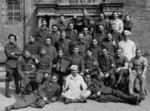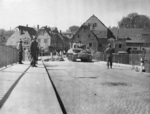Colditz Castle
| Type | 21 Prison Camp | |
| Historical Name of Location | Colditz, Sachsen, Germany | |
| Coordinates | 51.130783000, 12.807483000 |
This article has been removed for review and updates, please check back again soon!
Last Major Update: Jul 2013
Colditz Castle Interactive Map
Photographs
 |  |  |  |
Colditz Castle Timeline
| 1 Nov 1940 | The German Oflag IV-C prisoner of war camp at the Colditz Castle, until now a transit camp, was redesignated an actual holding camp as Polish prisoners of war were transferred there from nearby Oflag IV-A and Oflag VIII-B. |
| 6 Nov 1940 | Three Canadian prisoners of war who had previously served in the British Royal Air Force arrived at the Oflag IV-C camp at the Colditz Castle. The men were Donald Middleton, Keith Milne, and Howard Wardle. They were transferred from Oflag IX-A/H. |
| 27 Mar 1941 | The first transfers of prisoners out of Oflag IV-C camp at Colditz Castle in Germany took place; 27 Polish officers were moved to Oflag VII-B in Eichstätt, Germany. |
| 11 Apr 1941 | French Lieutenant Alain le Ray became the first Allied serviceman to escape from Colditz Castle, site of the prisoner of war camp Oflag IV-C, in Germany. |
| 10 May 1941 | British Lieutenant Anthony "Peter" Allan escaped the Oflag IV-C prisoner of war camp at Colditz Castle, Germany by hiding in a straw mattress that was being carried out of the camp by cooperative French laborers. |
| 12 May 1941 | Polish Lieutenant Mietek Chmiel and Lieutenant Miki Surmanowicz failed in their attempt to escape the Oflag IV-C prisoner of war camp at Colditz Castle, Germany. |
| 29 May 1941 | 13 British and Polish prisoners of war of Oflag IV-C at Colditz Castle, Germany attempted to escape via a tunnel, but the attempt was a failure. |
| 25 Jun 1941 | French Lieutenant E. Boulé, a prisoner of war at Oflag IV-C at Colditz Castle, Germany, was nearly successful at his escape. Dressed as a young German woman and readily walking away from the castle, he accidentally dropped his watch and was caught when a German guard returned the watch to him. |
| 2 Jul 1941 | French Lieutenant Pierre Mairesse Lebrun, a prisoner of war at Oflag IV-C at Colditz Castle, Germany, escaped the camp by leaping the wire fence and scaling outer brick wall. He would eventually successfully make it to Switzerland. |
| 17 Jul 1941 | The Oflag IV-C prisoners of war camp at Colditz Castle in Germany hosted a visit from the Orthodox Bishop of Dresden, Germany. |
| 18 Jul 1941 | The Orthodox Bishop of Dresden, Germany completed his two-day visit of the Oflag IV-C prisoners of war camp at Colditz Castle and departed. |
| 24 Jul 1941 | 68 Dutch officers arrived at the Oflag IV-C camp at Colditz Castle in Germany; they were the first Dutch prisoners at this prisoners of war camp. |
| 13 Aug 1941 | Dutch prisoners Dufour and Imitescaped the Oflag IV-C prisoner of war camp at Colditz Castle in Germany; they would be recaptured within a few days. |
| 16 Aug 1941 | Dutch prisoners Steinmetz and Larive escaped the Oflag IV-C prisoners of war camp at Colditz Castle in Germany; they would later become the first successful Dutch escapees of Colditz. |
| 28 Aug 1941 | British prisoner of war Lieutenant Airey Neave attempted to escape the Oflag IV-C camp at Colditz Castle in Germany with a fake German guard uniform; he was spotted near the front gate and captured. |
| 17 Dec 1941 | Five French prisoners of Oflag IV-C prisoners of war camp at Colditz Castle in Germany were sent to the town dentist for treatment. On the way back, escorted by two guards, three of them ran in three different directions; they would ultimately reach neutral territory successfully. |
| 5 Jan 1942 | Four prisoners of war, two Dutch and two British, successfully escaped the Oflag IV-C camp at Colditz Castle in Germany by dressing up as German guards. Lieutenant Airey Neave, one of the escapees among the four, became the first British to escape from Colditz. |
| 9 Jan 1942 | In Germany, 31 French officers were transferred from the Oflag IV-C prisoners of war camp at Colditz Castle to Oflag IV-D at Elsterhorst. |
| 19 May 1942 | All but 40 of the Polish prisoners at Oflag IV-C prisoners of war camp at Colditz Castle in Germany were transferred to another camp. |
| 9 Sep 1942 | Two British, one Australian, and three Dutch prisoners of Oflag IV-C prisoners of war camp at Colditz Castle in Germany made their escape, five disguised as Polish workers and the sixth as the German guard. Four of them would eventually be captured, but Royal Australian Air Force Flight Lieutenant Hedley Fowler and Royal Dutch Navy Lieutenant Damiaem van Doorninck would make it to Switzerland. |
| 7 Oct 1942 | A group of seven British and Canadian commandos (captured at Glomfjord, Norway) were transferred to Oflag IV-C prisoners of war camp at Colditz Castle in Germany. Later, they would all be executed at Sachsenhausen Concentration Camp per Adolf Hitler's Commando Order. |
| 14 Oct 1942 | Canadian Flying Officer Hank Wardle and British officers Major Ronnie Littledale, Captain Pat Reid, and Lieutenant-Commander Billie Stephens escaped from Oflag IV-C prisoners of war camp at Colditz Castle in Germany. All four would make it to Switzerland. |
| 22 Oct 1942 | The seven British and Canadian commandos transferred to Oflag IV-C prisoners of war camp at Colditz Castle in Germany earlier in the month were transferred out to Sachsenhausen Concentration Camp near Berlin, Germany, where they would soon face execution. |
| 15 Feb 1943 | Oberst Edgar Gläsche was relieved from his position as the commandant of the Oflag IV-C prisoners of war camp at Colditz Castle, Germany as he was transferred to Ukraine. He was to be replaced by Oberstleutnant Gerhard Prawitt. |
| 15 Feb 1943 | British prisoner of war Lieutenant Michael Alexander, who had conjured up a relationship with General Harold Alexander, was transferred to the Oflag IV-C camp at Colditz Castle in Germany; he was placed in the same cell with Giles Romilly, Winston Churchill's nephew. |
| 7 Jun 1943 | Dutch prisoners of war were transferred out of the Oflag IV-C camp at Colditz Castle in Germany for the camp at Stanislau in Ukraine; it had been decided in the previous month at Oflag IV-C was to house US and British prisoners only. |
| 6 Jul 1943 | French and Belgian prisoners of war began to be transferred out of the Oflag IV-C camp at Colditz Castle in Germany for the Oflag X-C camp in Lübeck; the transfer would continue until 12 Jul when the last French and Belgian prisoners were transferred out. |
| 4 Sep 1943 | A group of British prisoners of war at Oflag IV-C camp at Colditz Castle in Germany attempted to escape by having Lieutenant Mike Sinclair dress up as the respected WW1 veteran and now camp guard Stabsfeldwebel Fritz Rothenberger. The plan nearly succeeded before one of the guards grew suspicious and asked to see the pass from "Rothenberger". As the plan fell apart, Sinclair was shot in the chest by a pistol, though he would recover from the wound. |
| 28 Jan 1944 | Canadian prisoner of war Lieutenant Bill Millar hid underneath a Germany truck at the Oflag IV-C camp at Colditz Castle in Germany during an air raid and was able to escape the camp later when the truck was driven out of the camp. His fate after the escape was unknown, however. |
| 25 Sep 1944 | British prisoner of war Lieutenant Mike Sinclair was killed by a German guard while attempting to escape from the Oflag IV-C camp at Colditz Castle in Germany. He had attempted to escape several times prior, and through these attempted had earned the respect of his captors, who allowed the British prisoners to bury Sinclair with full military honors. |
| 26 Feb 1945 | 1,500 French prisoners of war arrived at the Oflag IV-C camp at Colditz Castle in Germany, having been transferred from the camp at Königstein. |
| 6 Apr 1945 | US Lieutenant John G. Winant, son of the US ambassador to Britain, captured after his aircraft was shot down over München (Munich), Germany, was transferred to the Oflag IV-C prisoner of war camp at Colditz Castle in Germany. |
| 12 Apr 1945 | Oberstleutnant Gerhard Prawitt, the commandant of the Oflag IV-C prisoner of war camp at Colditz Castle in Germany, received an unsigned letter from the office of Heinrich Himmler stating that all important prisoners at Colditz were to be prepared for transfer in the following morning where they would be held as hostages for negotiations with the western Allies. |
| 13 Apr 1945 | A group of prominent prisoners of war were transferred out of the Oflag IV-C camp at Colditz Castle in Germany for the camp at Laufen in southern Germany on the orders of Heinrich Himmler. |
| 15 Apr 1945 | Oberstleutnant Gerhard Prawitt, the commandant of the Oflag IV-C prisoner of war camp at Colditz Castle in Germany, received the order to transfer the prisoners in his charge toward the east. As he moved to carry out the order, the prisoners refused to cooperate as they knew the European War was coming to an end. By the evening, as US 9th Armored Division neared Colditz, SS guards began to flee without orders. |
| 16 Apr 1945 | US 9th Armored Division liberated the prisoners at the Oflag IV-C camp at the "escape-proof" Colditz Castle in Germany. US Private First Class Alan Murphey received the formal surrender from German Hauptmann Eggers at the courtyard of the castle. Throughout the war, 316 POWs attempted escapes from the castle with 32 making "home runs", which was the most of any camp. |
Please consider supporting us on Patreon. Even $1 per month will go a long way! Thank you. Please help us spread the word: Stay updated with WW2DB: |
Visitor Submitted Comments
All visitor submitted comments are opinions of those making the submissions and do not reflect views of WW2DB.

Colditz, Sachsen, Germany
Latitude-Longitude:
51.1308, 12.8075
- » 1,182 biographies
- » 337 events
- » 45,119 timeline entries
- » 1,249 ships
- » 350 aircraft models
- » 207 vehicle models
- » 376 weapon models
- » 123 historical documents
- » 261 facilities
- » 470 book reviews
- » 28,412 photos
- » 365 maps
Winston Churchill
Please consider supporting us on Patreon. Even $1 a month will go a long way. Thank you!
Or, please support us by purchasing some WW2DB merchandise at TeeSpring, Thank you!
8 Sep 2024 08:31:27 AM
The Fighting 69th Infantry squad arrived at Colditz before the tanks arrived. My Dad, Sargent Howard B. Gardner was there before sunrise and encountered an SS officer inspecting the bridge that the Germans tried to blowup. The officer, unaware of the Americans was quickly "dispatched". That's when the towns people began to file out of the town realizing they were liberated. When the soldiers reached the castle, the SS were gone! They had retreated. The 69th liberated the castle, not the armored Division. They also were 1st to meet the Russians on the Elbe, not the "politically correct" version that is documented. So it goes with politics! If you research you will find this version accurate. The small group of soldiers from the 69th moved on towards Berlin.